When Kansas City, Mo.-based Boulevard Brewing Co., now a part of Puurs, Belgium-based Duvel Moortgat, realized that the craft brewing business it had been building since 1989 was outgrowing its infrastructure and equipment, the company knew it needed to turn to automation to support its growth. In nearly 20 years of business, the company expanded distribution to 19 states and built its own three-story brewhouse in 2006, according to a recent case study released by Intelligrated, Mason, Ohio. However, until just before the company’s 20th anniversary milestone, all of the company’s palletizing was done by manpower.
The company’s 11 employees on the floor produced 300 bottles a minute, but the three workers that alternated the manual end-of-line palletizing operations stacked cases of the beer at a rate of 12 cases a minute, according to the case study. This discrepancy in palletizing was compounded by fatigue from stacking cases weighing up to 30 pounds each, creating a bottleneck in the production line, it notes.
“Automating the beginning (depalletizing) and end (palletizing) is a known factor in achieving higher production rates,” says Earl Wohlrab, palletizing and robotics system manager at Intelligrated. “These two processes are often bottlenecks for the operation, and as the operation grows, they require an ever-increasing labor force to manage the increasing rate.”
Although automation seemed like a good option for boosting productivity, the company had concerns about bottles being broken in the palletizing process, the case study notes. Industry trends of bottle thinning and removing corrugated partitions from secondary packaging, for both environmental and financial reasons, increased requirements for gentle handling, it reports.
The company ultimately decided to install Intelligrated’s Alvey 780 mid-speed palletizer to facilitate both increased production speeds and gentler handling, the case study says. The palletizer in the Kansas City facility accepts cases containing glass bottles in six-, 12- and 20-pack configurations, as well as 24-pack cases of aluminum bottles, via a high-level infeed. Then the palletizer forms the layers and lowers each completed layer to make room for the next layer until the pallet reaches ground level, where it is discharged via a full-pallet conveyor, it explains.
Following installation of the automated palletizer in 2009, the company was able to palletize 25 to 30 cases a minute, marking a more than 100 percent increase in production compared with its previous rates, and could change over to new pack patterns in 15 min-utes or less, Intelligrated says.
The needs trifecta
Boulevard Brewing’s story illustrates three of beverage companies’ biggest concerns when considering palletizing equipment. Customers look for performance, flexibility and safety from the equipment, says Ted Yeigh, sales director for Vancouver, Wash.-based Columbia Machine Inc.’s palletizer division. The first two go hand-in-hand in the current market environment. Although switching to automation allows beverage manufacturers to achieve higher throughput, companies also expect equipment to be flexible to accommodate a diverse SKU portfolio.
“The variety of package types means that the palletizer must be able to change from one SKU and/or package type to another instantaneously,” Yeigh says. To meet this production need, Columbia offers palletizers that automatically handle changeovers in zero time as part of the company’s standard controls package, he says.
Also standard on Columbia palletizers is a safety package that includes Category 3 electrical safety components, including Allen-Bradley’s SensaGuard dual-circuit safety interlocks and 6-foot-tall safety-rated light curtains to protect operators, Yeigh says.
While the other priorities are important for business, protecting employee assets is most important, says Stephane Banville, vice president of Gebo Cermex North America, Montreal. “Equipment safety has become a huge concern to many customers in the beverage industry, and they place more and more importance on this issue when purchasing palletizing and depalletizing equipment,” he says. To keep workers safe, the company designed its latest high-speed palletizer, EvoFlex, with safety in mind, he notes. “It achieves exceptionally high speeds with ground-level operations instead of the traditional high-level operations and, in this way, completely reduces the risk of accidents while improving the safety and efficiency of the operational and maintenance procedures,” he explains.
Safety also can refer to product safety as well. As packaging trends skew toward using less packaging material and, therefore, less protection for the product, beverage companies are seeking palletizers and depalletizers that offer gentle handling.
“A traditional bump-turn device may not work well with heavy product in a high-speed application with minimal protection of the product,” Yeigh explains. For gentler handling, beverage companies might turn toward more modern methods, such as robotic or hybrid palletizing. For example, Gebo Cermex North America’s EvoFlex hybrid palletizer offers two options for gentle product pick up: Robosmart, a robotic option, and Axosmart, a two-axis module option, Banville explains. Both applications are able to pick up the product and move it to its end position, he says.
Intelligrated also offers its Alvey 750 hybrid mid-speed palletizer. “[It] provides a cost-effective way to combine the flexibility of robotic palletizing with the durability and speed of conventional palletizing,” Wohlrab says. The Alvey 750 ensures gentle handling and load stability, making it ideal for handling lightweight and unstable products, he says.
Gebo Cermex predicts that hybrid palletizers will become even more popular as the lightweight packaging and reduced secondary packaging trends continue, Banville says.
These palletizers shine when it comes to palletizing difficult-to-handle packages, like tall, tippy products, Columbia’s Yeigh says. However, these applications tend to be very specific, and hybrid palletizers tend to be more expensive than other options, he notes.
Robotic palletizers also are growing in popularity, especially for handling bags and pouches, Yeigh says. Robots also excel at integrating packages from two to four different, slower-speed lines and palletizing them simultaneously, he adds.
Leaning on old reliable
However, conventional palletizers still are able to meet the needs of today’s beverage industry. In fact, many beverage operations are well suited for conventional equipment, Gebo Cermex’s Banville says. “The main reason for this is that many beverage lines are high-speed manufacturing lines, which require equipment capable of handling high speeds, and conventional palletizers are great at high speeds,” he explains.
Banville also notes that conventional palletizers are versatile, as they can handle various types of secondary packaging, including cases, trays and films. In addition, they are not affected by modifications in the pallet pattern, he notes.
As the cost of modern programmable logic controllers and human-machine interface technology has come down, it has become cost-effective to incorporate them into conventional palletizers for added flexibility, Columbia’s Yeigh says. This allows conventional palletizers to make changeovers from one product, SKU or size to the next almost instantaneously, he says.
Columbia’s conventional machines also use a four-way squeeze when depositing layers to build a tighter, better-quality load than most robotic palletizers, Yeigh says. For gentle handling, Columbia’s machines also offer a touch-free turning option to handle all package types easily and efficiently, he adds.
In terms of investment, conventional palletizers also tend to require a smaller space investment and a lower financial investment, making it a good option for a growing beverage company, Yeigh says.






